Tuesday, 20 July 2010: Ypres to Tournai, via France
Written 24 July 2010
The first order of business on Tuesday was our four-hour battlefield tour. 30 euros/head and well worth it. The Monday afternoon tour had been booked up, but on Tuesday morning we were the only ones to sign up, so we got the personal treatment and the whole tour in English. We accordingly got up promptly, breakfasted, packed, checked out of the hotel, and stashed our luggage in the hotel's storage room, and were just in time to meet our guide and his air-conditioned van right on the hotel's doorstep.
Our guide, who calls his service "Frontline Tours" is a retired bus driver who has been doing battlefield tours part time for three years and full-time for one year. He offers a variety of itineraries, each as either a 2-hour or a 4-hour tour. He says that seriously interested people spend five days with him, doing the whole range of tours. We had time only for one, so David chose the Battle of Paschendaele and Tyne Cot cemetery.
The first thing the guide showed us (during his introductory talk, before we even left the hotel's lobby, was a map of Normandy, strewn with blue dots, each marking a WWII-era military cemetery—sobering; we've been there and seen how frequent they are. Then he pulled out a map of the area surrounding Ypres, on which virtually all the roads and lettering are obscured by a carpet of blue dots—20 or 30 times as many as in all of Normandy. No wonder the Commonwealth War Graves Commission is based there. The death toll was appalling, well more than half of it arising from disease, starvation, and exposure rather than directly from enemy fire. As at Verdun, the entire landscape was obliterated, to the last blade of grass. At Verdun the mud was bad, but at Ypres, it was sometimes hip deep, and water in the trenches was sometimes chest deep, for days at a time. No Americans fought at Ypres.
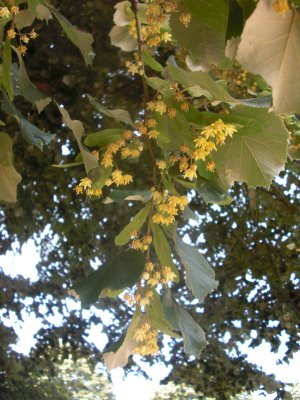 We first drove north out of town to the Essex Farm cemetery, where I got this shot of the flowers on one of the beautiful linden trees planted to shade it. Most recognizable locations and landmarks in the area were given English names by the commonwealth troops, who couldn't understand or remember the Dutch ones, and the farmhouse at that crossroads was dubbed Essex Farm. Some places were known by several different names to different military units. American military cemeteries tend to be nothing but grass, trees, and white crosses, whereas the commonwealth ones are usually planted with a profusion of flowers. The markers are more or less uniform, but each bears, in addition to the usual name, rank, and religious symbol, a quotation chosen by the family of the deceased and the insignia of the unit to which he belonged. A few bear other insignia, like the Victoria Cross (the commonwealth's highest military honor). Many, of course, just say, e.g., "An Australian soldier of the great war, known only unto God," or just "A soldier of the great war, known only unto God," when no one knows even which side the man fought on. At Essex Farm, most of the aisles are real grass, but the guide showed us one that has had to be carpeted with astroturf because foot traffic is so great that no grass can survive; it leads to a grave giving the soldier's age at death as 15 years. He told us of another, nearby, of a 14-year-old. At the beginning, boys heard their elders saying confidently that the war would be over by Christmas, so they lied about their ages and joined up early, so as not to miss the excitement.
We first drove north out of town to the Essex Farm cemetery, where I got this shot of the flowers on one of the beautiful linden trees planted to shade it. Most recognizable locations and landmarks in the area were given English names by the commonwealth troops, who couldn't understand or remember the Dutch ones, and the farmhouse at that crossroads was dubbed Essex Farm. Some places were known by several different names to different military units. American military cemeteries tend to be nothing but grass, trees, and white crosses, whereas the commonwealth ones are usually planted with a profusion of flowers. The markers are more or less uniform, but each bears, in addition to the usual name, rank, and religious symbol, a quotation chosen by the family of the deceased and the insignia of the unit to which he belonged. A few bear other insignia, like the Victoria Cross (the commonwealth's highest military honor). Many, of course, just say, e.g., "An Australian soldier of the great war, known only unto God," or just "A soldier of the great war, known only unto God," when no one knows even which side the man fought on. At Essex Farm, most of the aisles are real grass, but the guide showed us one that has had to be carpeted with astroturf because foot traffic is so great that no grass can survive; it leads to a grave giving the soldier's age at death as 15 years. He told us of another, nearby, of a 14-year-old. At the beginning, boys heard their elders saying confidently that the war would be over by Christmas, so they lied about their ages and joined up early, so as not to miss the excitement.
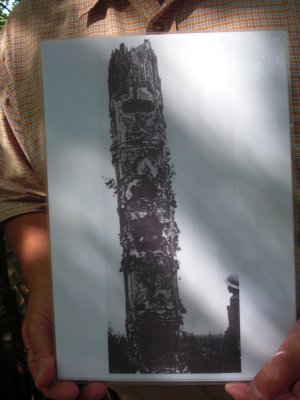 At each of the stops along the way, our guide showed us old maps, diagrams, and photos, including this one, of a phenomenon neither of us had come across in other accounts. It shows a metal blind in which a soldier could sit or stand in no-man's land and observe the German lines. It's a replica of a blasted tree stump—soldiers would creep out of the trenches into no-man's land, remove one of the few blasted tree stumps there, replace it, still under cover of darkness, with the replica and hope the Germans would not notice the difference.
At each of the stops along the way, our guide showed us old maps, diagrams, and photos, including this one, of a phenomenon neither of us had come across in other accounts. It shows a metal blind in which a soldier could sit or stand in no-man's land and observe the German lines. It's a replica of a blasted tree stump—soldiers would creep out of the trenches into no-man's land, remove one of the few blasted tree stumps there, replace it, still under cover of darkness, with the replica and hope the Germans would not notice the difference.
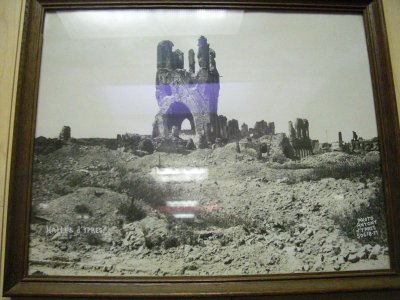 Another of his photos showed downtown Ypres at the end of the fighting. The lump in the middle is all that remained of the cloth hall.
Another of his photos showed downtown Ypres at the end of the fighting. The lump in the middle is all that remained of the cloth hall.
Our next stop was a row of concrete bunkers, which served as an advance dressing and triage station during the fighting. The first in the row was used as an operating room. One of the surgeons who worked there was John McCrae, of the Canadian Expeditionary Force. On the day in 1915 when his best friend was brought in, severely wounded by shell fragments, and died under his hands, he took a 20-minute break from work and wrote the famous poem, "In Flanders fields the poppies blow/Between the crosses, row on row/ . . ." A bronze plaque near the door to the bunker commemorates the occasion and reproduces his manuscript copy of the poem. It also notes the date in 1918 when McCrae himself died on some other WWI battlefield. The poem is also painted on the wall of the lobby of the Novotel, near a display of a couple of white calla lilies draped in black.
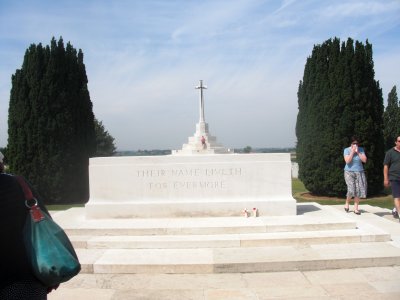
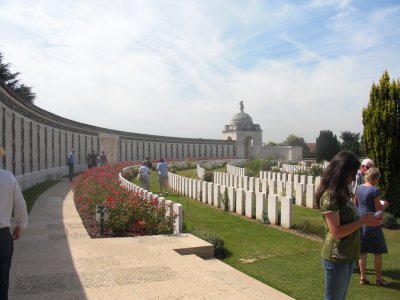 We next visited Tyne Cot cemetery, the largest commonwealth war cemetery in the world. Tyne Cot is another English place name, derived from "Tyne Cottage." The inscription on the stone in the foreground of the left-hand photo (like a similar stone at each of the other cemeteries we visited) says "Their name liveth for evermore," which our guide attributed to Rudyard Kipling. Kipling headed the Commonwealth War Graves Commission after the war. His son Jack died at Ypres, and the remains have never been found. In addition to the thousands of grave markers,
the long curving stone wall in the right-hand photo is engraved with the names of the dead with no known graves. The photo shows only part of the wall, and the wall is broken at intervals by circular recesses that greatly increase its area, yet these are only the names that would not fit on the Menin Gate at Ypres, where the list was begun. Tyne Cot couldn't hold them all either, so the list continues at some other cemetery we didn't visit. From one to 40 bodies are still found each year, and some are identified; those names are removed from the gate or wall.
We next visited Tyne Cot cemetery, the largest commonwealth war cemetery in the world. Tyne Cot is another English place name, derived from "Tyne Cottage." The inscription on the stone in the foreground of the left-hand photo (like a similar stone at each of the other cemeteries we visited) says "Their name liveth for evermore," which our guide attributed to Rudyard Kipling. Kipling headed the Commonwealth War Graves Commission after the war. His son Jack died at Ypres, and the remains have never been found. In addition to the thousands of grave markers,
the long curving stone wall in the right-hand photo is engraved with the names of the dead with no known graves. The photo shows only part of the wall, and the wall is broken at intervals by circular recesses that greatly increase its area, yet these are only the names that would not fit on the Menin Gate at Ypres, where the list was begun. Tyne Cot couldn't hold them all either, so the list continues at some other cemetery we didn't visit. From one to 40 bodies are still found each year, and some are identified; those names are removed from the gate or wall.
Written 27 July 2010
Others who fought at Ypres were C. S. Lewis (authorities claim to see many references to the experience in his literary works) and Erich Marie Remark (real name "Kramer," which he reversed as a pen name), author of All Quiet on the Western Front, who was wounded nearby at a windmill called "the mill of death" that was frequently shelled.
We visited a German cemetery, which differed from we'd seen before. In France, German WWI and WWII cemeteries were rows of black iron or stone crosses, but this one had only a few groups of three of such crosses scattered about as ornamentation. The actual grave markers were back stone squares lying flat on the ground. Some bore the names of one to our individuals, but many more just said "Four (or, sometimes, "Twenty") German soldiers of the Great War." In the center of the cemetery, a single large square plot was marked out. It was planted with flowering shrubs and surrounded by a gravel path, and a plaque indicated that it marked the mass gave of 44,061 unidentified combatants. As "Ypres" is to the British and commonwealth psyche, so nearby "Langemarke" is to the Germans—the battle that left the greatest scar.
We stopped briefly at a small monument placed a few years ago by Harry Patch, the last living veteran of the battle. He was about 111 years old at the time and a short while later.
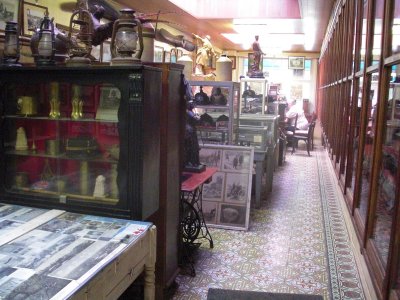
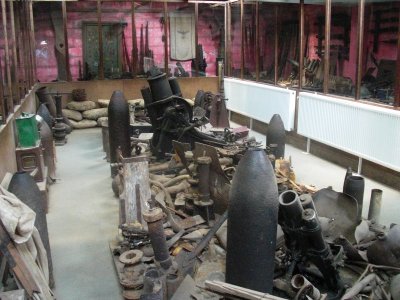 Another stop was this small but densely packed museum, owned and run by the descendents of a landowner who had the foresight to leave the trenches through his land just as they were and to collect all the objects found there (plus others that he would acquire). The heap in the right-hand photo gives an idea of the kind of stuff found in the ground all over the area. About 300 tons of ordnance (some of it exploded and some not) are found and removed yearly; two to three trucks/day pass through the town of Ypres, hauling ordnance. Also, even now, old tunnels and "dugouts" continue to be discovered (usually when they collapse); we saw photos taken in 1999 of a huge hole that opened in the middle of a driveway under the feet of a housewife who went out to collect the morning mail. She fell about 15 feet, but escaped injury.
Another stop was this small but densely packed museum, owned and run by the descendents of a landowner who had the foresight to leave the trenches through his land just as they were and to collect all the objects found there (plus others that he would acquire). The heap in the right-hand photo gives an idea of the kind of stuff found in the ground all over the area. About 300 tons of ordnance (some of it exploded and some not) are found and removed yearly; two to three trucks/day pass through the town of Ypres, hauling ordnance. Also, even now, old tunnels and "dugouts" continue to be discovered (usually when they collapse); we saw photos taken in 1999 of a huge hole that opened in the middle of a driveway under the feet of a housewife who went out to collect the morning mail. She fell about 15 feet, but escaped injury.
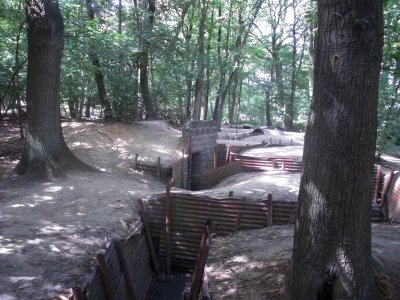 Behind the museum, we saw heaps of rusty old rolls of barbed wire, piles of horse bones, trenching tools, more assorted ironmongery, and part of this system of trenches. The trenches we saw at Vimy Ridge in France a couple of years ago have been reinforced and lined with concrete (disguised as sandbags) for stability. These are the actual, original trenches. The soil in this area is a heavy clay, and given the chance, it sets up like cement, so the trenches have held their shape without reinforcement other than the corrugated iron used at the time. This was a second-line, support trench. The front-line trenches are out of sight through the trees to the left. They can also be visited, but we didn't take the time.
Behind the museum, we saw heaps of rusty old rolls of barbed wire, piles of horse bones, trenching tools, more assorted ironmongery, and part of this system of trenches. The trenches we saw at Vimy Ridge in France a couple of years ago have been reinforced and lined with concrete (disguised as sandbags) for stability. These are the actual, original trenches. The soil in this area is a heavy clay, and given the chance, it sets up like cement, so the trenches have held their shape without reinforcement other than the corrugated iron used at the time. This was a second-line, support trench. The front-line trenches are out of sight through the trees to the left. They can also be visited, but we didn't take the time.
The trenches were always dug in this zigzag fashion, for two reasons. First, if the trenches were straight, a shell falling into the trench would injure its occupants for yards on either side. The zigs and zags served as baffles to limit the damage to a short stretch of trench. Second, any enemy soldiers who charged across no-man's land and got into a straight trench could shoot lengthwise of it, at many targets, whereas in this zigzag arrangement, they couldn't.
The museum also housed about a dozen of the wooden 3D photoviewers we were so impressed with at Compiegne. The period 3D photos (several dozen in each viewer) give a really startling view of the events and terrain at the time. You could spend a whole day just looking at those photos, whereas we had time only to flip through one of the viewers each.
The tour circled about 90 degrees around the town of Ypres, toward the east, along the top of the crescent of hills that made the town such a focal point of battle. That arc of high ground maintained Ypres and its outskirts as a salient into German-held territory for years. At one point the allies fought for 100 days to gain just enough forward progress to gain control of those hills (they never even got out of sight of the town) before the Germans put on a surge and gained it all back in three days.
At the end of the arc, we reapproached Ypres, this time from the east, along the Menin Road (i.e., the road to Ypres from the town of Menin). We passed through a crossroads only a kilometer or two out of town that, during WWI was called "Hellfire Corner." Because it was such an important transportation hub, the Germans shelled it incessantly, and the land around it was too soft and broken for vehicle traffic which had to stay on the road, so anyone who approached it from any direction took a deep breath, whipped up his horses or broke into a run, and dashed through it at top speed, hoping to run between the shells, as it were. Assignment to the detail charged with constant repair of the roads there was particular dreaded.
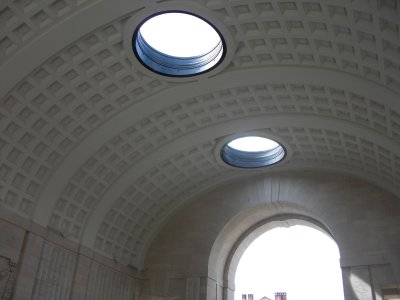
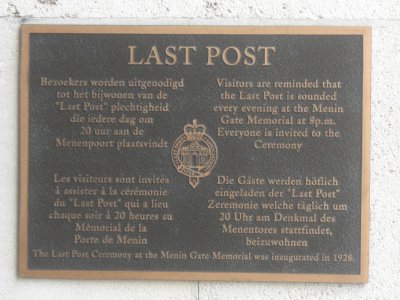 We reentered the town through the Menin Gate, which serves as a monument to the dead. The photo at the left shows part of its beautiful marble vaulted ceiling. Below are the rows of names of those without known graves, continued at Tyne Cot. In the middle of the roadway at the mouth of the gate is painted a round white spot, which marks where a bugler stands every evening at 8:00 p.m. to sound the British bugle call "Last Post." Traffic is stopped and, depending on the day, anywhere from hundreds to thousands of people assemble to listen.
We reentered the town through the Menin Gate, which serves as a monument to the dead. The photo at the left shows part of its beautiful marble vaulted ceiling. Below are the rows of names of those without known graves, continued at Tyne Cot. In the middle of the roadway at the mouth of the gate is painted a round white spot, which marks where a bugler stands every evening at 8:00 p.m. to sound the British bugle call "Last Post." Traffic is stopped and, depending on the day, anywhere from hundreds to thousands of people assemble to listen.
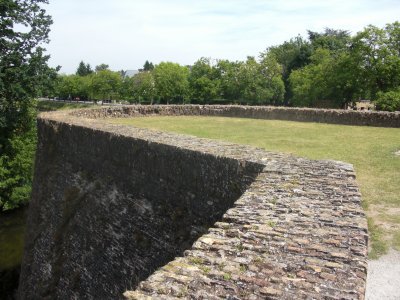 The ceremony has taken place every day since 1938, except when Ypres was occupied by the Germans during WWII; Hitler forbade it. But it was resumed the very day the war ended.
The ceremony has taken place every day since 1938, except when Ypres was occupied by the Germans during WWII; Hitler forbade it. But it was resumed the very day the war ended.
From a platform partway up the outside wall of the gate, I got this shot of some of the old Vauban fortifications, which have stood through all the wars since his time.
Throughout the tour, our guide volunteered reams of information, and at every stop showed us photos. For example, I had no idea that mustard gas was odorless and could only be detected if the soldiers saw the shells arrive that produced it! The original poison gas used at Ypres was chlorine. The Germans deployed rows of tanks in their trenches, ran hoses up out of the trenches, hand down by mounts of soil so that their spouts pointed toward the allied lines, waited for the wind to be right, and opened the valves. The gas blew, as visible clouds of what looked like smoke, toward the allied lines, where it tended to settle into the trenches.
Mustard gas, though, was produced by evaporation from a gummy substance that could be packed into cannon shells and lobbed into allied territory, where it blew up and splattered everywhere. Up to a week later, a glob of it could still be slowly evaporating and, because it was odorless and colorless, poison anyone who happened to walk by.
He showed us several photos of Hitler visiting Ypres and other places in the area during the occupation, and explained how, after the war, while the authorities were debating whether or not Ypres should be rebuilt or kept as it was as a memorial, the residents came back and started rebuilding without asking, so the decision was made de facto. An excellent tour altogether.
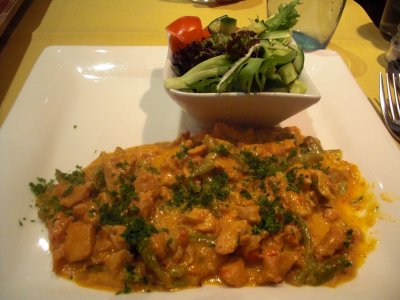
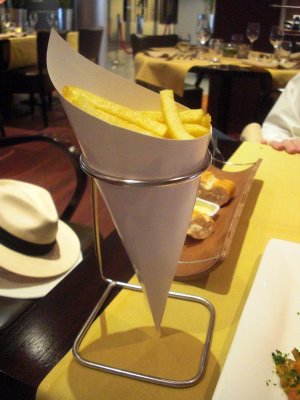 By the time we got back to the hotel at 1 p.m., David was feeling pretty crummy from the remains of his cold, so we decided just to grab a bite at the hotel's restaurant before hitting the road. Unfortunately, lunch at the hotel is served at 12 noon, so it was essentially over, and the menu is set. They were willing to serve us, though, so I got the set menu—tomato soup, something that sounded like "heroes" and turned out to be minced cooked chicken in a tomato cream sauce with onions and peppers (surprisingly good, actually), and coffee. David just got the soup. I didn't want the coffee, so the waiter gave me a couple of bottles of water for the road, in lieu. The frites that came with the main course were supported by this handy wire rack, so that they could be served in the proper paper cone.
By the time we got back to the hotel at 1 p.m., David was feeling pretty crummy from the remains of his cold, so we decided just to grab a bite at the hotel's restaurant before hitting the road. Unfortunately, lunch at the hotel is served at 12 noon, so it was essentially over, and the menu is set. They were willing to serve us, though, so I got the set menu—tomato soup, something that sounded like "heroes" and turned out to be minced cooked chicken in a tomato cream sauce with onions and peppers (surprisingly good, actually), and coffee. David just got the soup. I didn't want the coffee, so the waiter gave me a couple of bottles of water for the road, in lieu. The frites that came with the main course were supported by this handy wire rack, so that they could be served in the proper paper cone.
Then it was off to Tournai, tied with one other place for the title of oldest city in Belgium—and not, so far as we know, the focus of any particular war. And again, the rather cavalier European attitude toward route numbers steered us off in an unexpected direction, and once again, we wound up in France. So never let it be said that we didn't go to France in 2010—we were there twice!
Then my preplotted route worked, we entered town, found the ring road, turned toward the center at the right point, but as usual missed our next turn. We knew it as soon as we did it, but in those twisty little medieval towns, there's no going back. Everything is one-way. So David pulled into a nearby parking space, and I set off on foot to ask the hotel's advice on how to get the car to them and where we could park it. The nice lady at reception in the Hotel d'Alcantara gave me a map and traced a route on it that we were able to follow in only two tries (missed another turn but were able to circle the "block," actually a triangle).
The route to the hotel led through the "Grande Place," a beautiful triangular square (as it were) lined on all sides with handsome historic buildingsand attractive cafés and and restaurants. All the way around it, at second-floor level, were banners with the names and insignia of the town's historic guilds—tanners, dyers, painters, plumbers, goldsmiths, fishermen, butchers, roofers, farriers, weavers, locksmiths, potters, spinners, brewers; about 30 in all. Unfortunately, the center of the square had been marked off as a parking lot, and waist-high pylons outlined traffic routes through it in two or three directions. David's comment was, "This would be gorgeous, if they could just get the cars out of it!
Our restaurants for the next two nights were both in the Grande Place, a short stroll from the hotel, so after resting our feet, we made our way there, to restaurant "Le Carillon" (named for the nearby bell tower, just outside the square), which promptly restored our faith in European cuisine.
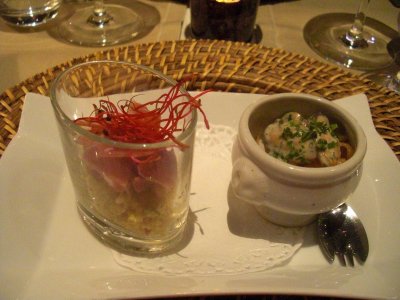 The amuse-bouch was two-fold: (1) a glass with guacamole in the bottom, topped with slivers of smoked salmon and tasty red onion sprouts, and (2) a little pot of warm mussels in cream sauce. Both delicious. I ate the onions and salmon off the top of mine and gave the guacamole to David.
The amuse-bouch was two-fold: (1) a glass with guacamole in the bottom, topped with slivers of smoked salmon and tasty red onion sprouts, and (2) a little pot of warm mussels in cream sauce. Both delicious. I ate the onions and salmon off the top of mine and gave the guacamole to David.
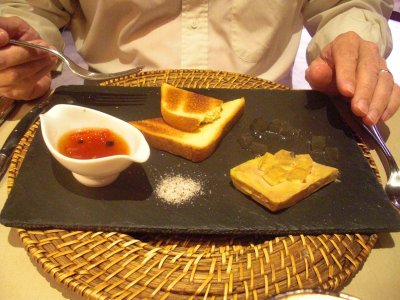 David started with cold foie gras topped with cubes of flavorful white-wine jelly and accompanied by brioche toast and a spicy sweet tomato jam dotted with peppercorns. Excellent, especially the jam, which went beautifully with the liver.
David started with cold foie gras topped with cubes of flavorful white-wine jelly and accompanied by brioche toast and a spicy sweet tomato jam dotted with peppercorns. Excellent, especially the jam, which went beautifully with the liver.
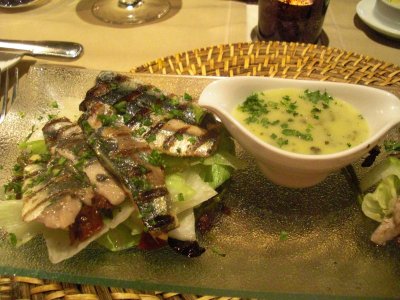 My starter was warm grilled filets of fresh sardine on a salad of iceberg lettuce (very unusual in Europe) and a mild, creamy vinaigrette. The menu said the sardines would come with Salicornia, but they must have been been out—fair enough, as we've several times been served unadvertised Salicornia because they were out of something else.
My starter was warm grilled filets of fresh sardine on a salad of iceberg lettuce (very unusual in Europe) and a mild, creamy vinaigrette. The menu said the sardines would come with Salicornia, but they must have been been out—fair enough, as we've several times been served unadvertised Salicornia because they were out of something else.
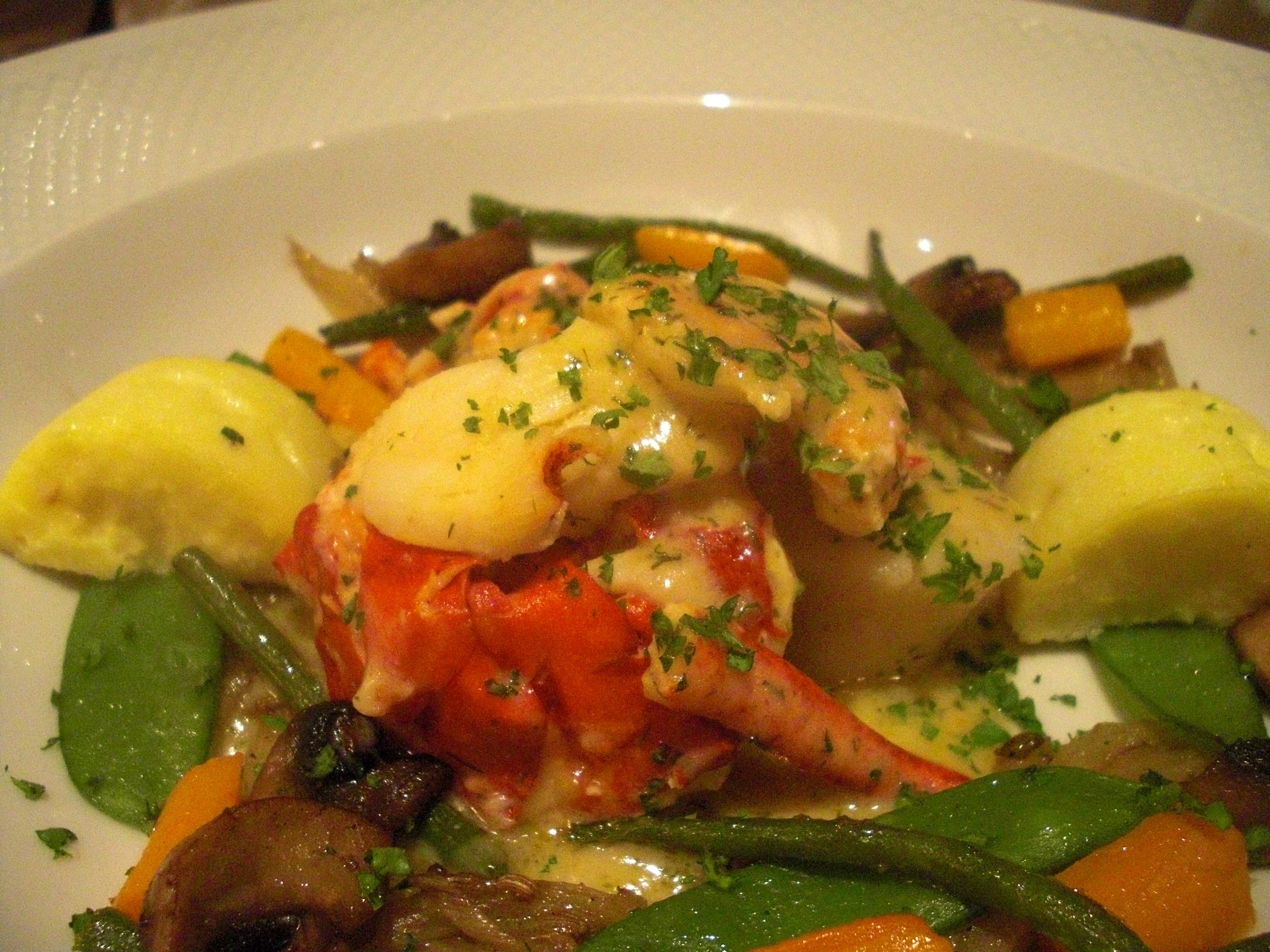 David then had "waterzooi" of lobster and scallops with baby vegetables. A waterzooi is ordinarily a cream-based soup or thin stew of chicken or fish, but this one had only a small amount of creamy sauce, plus mushrooms and half-circles of polenta. David loved it.
David then had "waterzooi" of lobster and scallops with baby vegetables. A waterzooi is ordinarily a cream-based soup or thin stew of chicken or fish, but this one had only a small amount of creamy sauce, plus mushrooms and half-circles of polenta. David loved it.
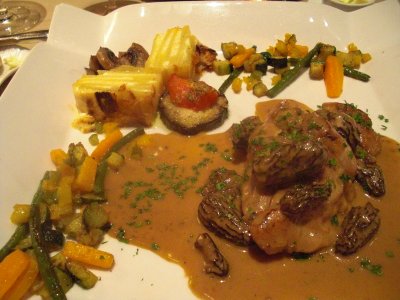 My main course was veal sweetbreads with "strongly flavored veal sauce" and morel mushrooms (reconsituted from the dry state, I assume, as morels were way out of season). Excellent! Even more excellent were the two slices of gratin dauphinois (potatoes layered with garlic, eggs, and cream and baked until tender throughout. Even the ordinarily looking diced vegetables, the mushrooms, and the slice of eggplant with tomato on top were just bursting with flavor. The sweetbreads were smoothly creamy, and the sauce and morels richly flavored. An absolutely outstanding dish; a contender for best of trip.
My main course was veal sweetbreads with "strongly flavored veal sauce" and morel mushrooms (reconsituted from the dry state, I assume, as morels were way out of season). Excellent! Even more excellent were the two slices of gratin dauphinois (potatoes layered with garlic, eggs, and cream and baked until tender throughout. Even the ordinarily looking diced vegetables, the mushrooms, and the slice of eggplant with tomato on top were just bursting with flavor. The sweetbreads were smoothly creamy, and the sauce and morels richly flavored. An absolutely outstanding dish; a contender for best of trip.
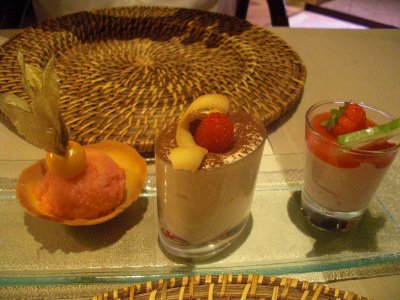 For dessert, we split a "déclinaison de petits desserts sur le thème de la fraise," i.e. a declension of small desserts on the theme of the strawberry—from left to right, a scoop of strawberry sorbet in a cookie cup topped with a Physalis fruit, a glass of strawberries topped with rich vanilla panna cotta and a sprinkling of cocoa and cinnamon, and a fluffy strawberry mousse. The green object at the right is a slice of carambola (star fruit), viewed edge on. All delicious.
For dessert, we split a "déclinaison de petits desserts sur le thème de la fraise," i.e. a declension of small desserts on the theme of the strawberry—from left to right, a scoop of strawberry sorbet in a cookie cup topped with a Physalis fruit, a glass of strawberries topped with rich vanilla panna cotta and a sprinkling of cocoa and cinnamon, and a fluffy strawberry mousse. The green object at the right is a slice of carambola (star fruit), viewed edge on. All delicious.
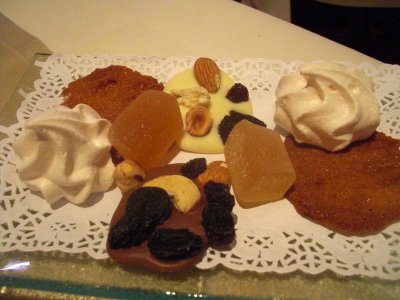 We even had appetite left for some of the mignardises: pastilles of chocolate with various nuts and dried fruit embedded in them, cubes of sugar-coated fruit paste, cinnamon cookies, and crisp meringue kisses.
We even had appetite left for some of the mignardises: pastilles of chocolate with various nuts and dried fruit embedded in them, cubes of sugar-coated fruit paste, cinnamon cookies, and crisp meringue kisses.
We highly recommend "Le Carillon" in Tournai.
previous entry
List of Entries
next entry
 We first drove north out of town to the Essex Farm cemetery, where I got this shot of the flowers on one of the beautiful linden trees planted to shade it. Most recognizable locations and landmarks in the area were given English names by the commonwealth troops, who couldn't understand or remember the Dutch ones, and the farmhouse at that crossroads was dubbed Essex Farm. Some places were known by several different names to different military units. American military cemeteries tend to be nothing but grass, trees, and white crosses, whereas the commonwealth ones are usually planted with a profusion of flowers. The markers are more or less uniform, but each bears, in addition to the usual name, rank, and religious symbol, a quotation chosen by the family of the deceased and the insignia of the unit to which he belonged. A few bear other insignia, like the Victoria Cross (the commonwealth's highest military honor). Many, of course, just say, e.g., "An Australian soldier of the great war, known only unto God," or just "A soldier of the great war, known only unto God," when no one knows even which side the man fought on. At Essex Farm, most of the aisles are real grass, but the guide showed us one that has had to be carpeted with astroturf because foot traffic is so great that no grass can survive; it leads to a grave giving the soldier's age at death as 15 years. He told us of another, nearby, of a 14-year-old. At the beginning, boys heard their elders saying confidently that the war would be over by Christmas, so they lied about their ages and joined up early, so as not to miss the excitement.
We first drove north out of town to the Essex Farm cemetery, where I got this shot of the flowers on one of the beautiful linden trees planted to shade it. Most recognizable locations and landmarks in the area were given English names by the commonwealth troops, who couldn't understand or remember the Dutch ones, and the farmhouse at that crossroads was dubbed Essex Farm. Some places were known by several different names to different military units. American military cemeteries tend to be nothing but grass, trees, and white crosses, whereas the commonwealth ones are usually planted with a profusion of flowers. The markers are more or less uniform, but each bears, in addition to the usual name, rank, and religious symbol, a quotation chosen by the family of the deceased and the insignia of the unit to which he belonged. A few bear other insignia, like the Victoria Cross (the commonwealth's highest military honor). Many, of course, just say, e.g., "An Australian soldier of the great war, known only unto God," or just "A soldier of the great war, known only unto God," when no one knows even which side the man fought on. At Essex Farm, most of the aisles are real grass, but the guide showed us one that has had to be carpeted with astroturf because foot traffic is so great that no grass can survive; it leads to a grave giving the soldier's age at death as 15 years. He told us of another, nearby, of a 14-year-old. At the beginning, boys heard their elders saying confidently that the war would be over by Christmas, so they lied about their ages and joined up early, so as not to miss the excitement. At each of the stops along the way, our guide showed us old maps, diagrams, and photos, including this one, of a phenomenon neither of us had come across in other accounts. It shows a metal blind in which a soldier could sit or stand in no-man's land and observe the German lines. It's a replica of a blasted tree stump—soldiers would creep out of the trenches into no-man's land, remove one of the few blasted tree stumps there, replace it, still under cover of darkness, with the replica and hope the Germans would not notice the difference.
At each of the stops along the way, our guide showed us old maps, diagrams, and photos, including this one, of a phenomenon neither of us had come across in other accounts. It shows a metal blind in which a soldier could sit or stand in no-man's land and observe the German lines. It's a replica of a blasted tree stump—soldiers would creep out of the trenches into no-man's land, remove one of the few blasted tree stumps there, replace it, still under cover of darkness, with the replica and hope the Germans would not notice the difference. Another of his photos showed downtown Ypres at the end of the fighting. The lump in the middle is all that remained of the cloth hall.
Another of his photos showed downtown Ypres at the end of the fighting. The lump in the middle is all that remained of the cloth hall.
 We next visited Tyne Cot cemetery, the largest commonwealth war cemetery in the world. Tyne Cot is another English place name, derived from "Tyne Cottage." The inscription on the stone in the foreground of the left-hand photo (like a similar stone at each of the other cemeteries we visited) says "Their name liveth for evermore," which our guide attributed to Rudyard Kipling. Kipling headed the Commonwealth War Graves Commission after the war. His son Jack died at Ypres, and the remains have never been found. In addition to the thousands of grave markers,
the long curving stone wall in the right-hand photo is engraved with the names of the dead with no known graves. The photo shows only part of the wall, and the wall is broken at intervals by circular recesses that greatly increase its area, yet these are only the names that would not fit on the Menin Gate at Ypres, where the list was begun. Tyne Cot couldn't hold them all either, so the list continues at some other cemetery we didn't visit. From one to 40 bodies are still found each year, and some are identified; those names are removed from the gate or wall.
We next visited Tyne Cot cemetery, the largest commonwealth war cemetery in the world. Tyne Cot is another English place name, derived from "Tyne Cottage." The inscription on the stone in the foreground of the left-hand photo (like a similar stone at each of the other cemeteries we visited) says "Their name liveth for evermore," which our guide attributed to Rudyard Kipling. Kipling headed the Commonwealth War Graves Commission after the war. His son Jack died at Ypres, and the remains have never been found. In addition to the thousands of grave markers,
the long curving stone wall in the right-hand photo is engraved with the names of the dead with no known graves. The photo shows only part of the wall, and the wall is broken at intervals by circular recesses that greatly increase its area, yet these are only the names that would not fit on the Menin Gate at Ypres, where the list was begun. Tyne Cot couldn't hold them all either, so the list continues at some other cemetery we didn't visit. From one to 40 bodies are still found each year, and some are identified; those names are removed from the gate or wall. 
 Another stop was this small but densely packed museum, owned and run by the descendents of a landowner who had the foresight to leave the trenches through his land just as they were and to collect all the objects found there (plus others that he would acquire). The heap in the right-hand photo gives an idea of the kind of stuff found in the ground all over the area. About 300 tons of ordnance (some of it exploded and some not) are found and removed yearly; two to three trucks/day pass through the town of Ypres, hauling ordnance. Also, even now, old tunnels and "dugouts" continue to be discovered (usually when they collapse); we saw photos taken in 1999 of a huge hole that opened in the middle of a driveway under the feet of a housewife who went out to collect the morning mail. She fell about 15 feet, but escaped injury.
Another stop was this small but densely packed museum, owned and run by the descendents of a landowner who had the foresight to leave the trenches through his land just as they were and to collect all the objects found there (plus others that he would acquire). The heap in the right-hand photo gives an idea of the kind of stuff found in the ground all over the area. About 300 tons of ordnance (some of it exploded and some not) are found and removed yearly; two to three trucks/day pass through the town of Ypres, hauling ordnance. Also, even now, old tunnels and "dugouts" continue to be discovered (usually when they collapse); we saw photos taken in 1999 of a huge hole that opened in the middle of a driveway under the feet of a housewife who went out to collect the morning mail. She fell about 15 feet, but escaped injury. Behind the museum, we saw heaps of rusty old rolls of barbed wire, piles of horse bones, trenching tools, more assorted ironmongery, and part of this system of trenches. The trenches we saw at Vimy Ridge in France a couple of years ago have been reinforced and lined with concrete (disguised as sandbags) for stability. These are the actual, original trenches. The soil in this area is a heavy clay, and given the chance, it sets up like cement, so the trenches have held their shape without reinforcement other than the corrugated iron used at the time. This was a second-line, support trench. The front-line trenches are out of sight through the trees to the left. They can also be visited, but we didn't take the time.
Behind the museum, we saw heaps of rusty old rolls of barbed wire, piles of horse bones, trenching tools, more assorted ironmongery, and part of this system of trenches. The trenches we saw at Vimy Ridge in France a couple of years ago have been reinforced and lined with concrete (disguised as sandbags) for stability. These are the actual, original trenches. The soil in this area is a heavy clay, and given the chance, it sets up like cement, so the trenches have held their shape without reinforcement other than the corrugated iron used at the time. This was a second-line, support trench. The front-line trenches are out of sight through the trees to the left. They can also be visited, but we didn't take the time.
 We reentered the town through the Menin Gate, which serves as a monument to the dead. The photo at the left shows part of its beautiful marble vaulted ceiling. Below are the rows of names of those without known graves, continued at Tyne Cot. In the middle of the roadway at the mouth of the gate is painted a round white spot, which marks where a bugler stands every evening at 8:00 p.m. to sound the British bugle call "Last Post." Traffic is stopped and, depending on the day, anywhere from hundreds to thousands of people assemble to listen.
We reentered the town through the Menin Gate, which serves as a monument to the dead. The photo at the left shows part of its beautiful marble vaulted ceiling. Below are the rows of names of those without known graves, continued at Tyne Cot. In the middle of the roadway at the mouth of the gate is painted a round white spot, which marks where a bugler stands every evening at 8:00 p.m. to sound the British bugle call "Last Post." Traffic is stopped and, depending on the day, anywhere from hundreds to thousands of people assemble to listen. The ceremony has taken place every day since 1938, except when Ypres was occupied by the Germans during WWII; Hitler forbade it. But it was resumed the very day the war ended.
The ceremony has taken place every day since 1938, except when Ypres was occupied by the Germans during WWII; Hitler forbade it. But it was resumed the very day the war ended.
 By the time we got back to the hotel at 1 p.m., David was feeling pretty crummy from the remains of his cold, so we decided just to grab a bite at the hotel's restaurant before hitting the road. Unfortunately, lunch at the hotel is served at 12 noon, so it was essentially over, and the menu is set. They were willing to serve us, though, so I got the set menu—tomato soup, something that sounded like "heroes" and turned out to be minced cooked chicken in a tomato cream sauce with onions and peppers (surprisingly good, actually), and coffee. David just got the soup. I didn't want the coffee, so the waiter gave me a couple of bottles of water for the road, in lieu. The frites that came with the main course were supported by this handy wire rack, so that they could be served in the proper paper cone.
By the time we got back to the hotel at 1 p.m., David was feeling pretty crummy from the remains of his cold, so we decided just to grab a bite at the hotel's restaurant before hitting the road. Unfortunately, lunch at the hotel is served at 12 noon, so it was essentially over, and the menu is set. They were willing to serve us, though, so I got the set menu—tomato soup, something that sounded like "heroes" and turned out to be minced cooked chicken in a tomato cream sauce with onions and peppers (surprisingly good, actually), and coffee. David just got the soup. I didn't want the coffee, so the waiter gave me a couple of bottles of water for the road, in lieu. The frites that came with the main course were supported by this handy wire rack, so that they could be served in the proper paper cone. The amuse-bouch was two-fold: (1) a glass with guacamole in the bottom, topped with slivers of smoked salmon and tasty red onion sprouts, and (2) a little pot of warm mussels in cream sauce. Both delicious. I ate the onions and salmon off the top of mine and gave the guacamole to David.
The amuse-bouch was two-fold: (1) a glass with guacamole in the bottom, topped with slivers of smoked salmon and tasty red onion sprouts, and (2) a little pot of warm mussels in cream sauce. Both delicious. I ate the onions and salmon off the top of mine and gave the guacamole to David. David started with cold foie gras topped with cubes of flavorful white-wine jelly and accompanied by brioche toast and a spicy sweet tomato jam dotted with peppercorns. Excellent, especially the jam, which went beautifully with the liver.
David started with cold foie gras topped with cubes of flavorful white-wine jelly and accompanied by brioche toast and a spicy sweet tomato jam dotted with peppercorns. Excellent, especially the jam, which went beautifully with the liver. My starter was warm grilled filets of fresh sardine on a salad of iceberg lettuce (very unusual in Europe) and a mild, creamy vinaigrette. The menu said the sardines would come with Salicornia, but they must have been been out—fair enough, as we've several times been served unadvertised Salicornia because they were out of something else.
My starter was warm grilled filets of fresh sardine on a salad of iceberg lettuce (very unusual in Europe) and a mild, creamy vinaigrette. The menu said the sardines would come with Salicornia, but they must have been been out—fair enough, as we've several times been served unadvertised Salicornia because they were out of something else. David then had "waterzooi" of lobster and scallops with baby vegetables. A waterzooi is ordinarily a cream-based soup or thin stew of chicken or fish, but this one had only a small amount of creamy sauce, plus mushrooms and half-circles of polenta. David loved it.
David then had "waterzooi" of lobster and scallops with baby vegetables. A waterzooi is ordinarily a cream-based soup or thin stew of chicken or fish, but this one had only a small amount of creamy sauce, plus mushrooms and half-circles of polenta. David loved it. My main course was veal sweetbreads with "strongly flavored veal sauce" and morel mushrooms (reconsituted from the dry state, I assume, as morels were way out of season). Excellent! Even more excellent were the two slices of gratin dauphinois (potatoes layered with garlic, eggs, and cream and baked until tender throughout. Even the ordinarily looking diced vegetables, the mushrooms, and the slice of eggplant with tomato on top were just bursting with flavor. The sweetbreads were smoothly creamy, and the sauce and morels richly flavored. An absolutely outstanding dish; a contender for best of trip.
My main course was veal sweetbreads with "strongly flavored veal sauce" and morel mushrooms (reconsituted from the dry state, I assume, as morels were way out of season). Excellent! Even more excellent were the two slices of gratin dauphinois (potatoes layered with garlic, eggs, and cream and baked until tender throughout. Even the ordinarily looking diced vegetables, the mushrooms, and the slice of eggplant with tomato on top were just bursting with flavor. The sweetbreads were smoothly creamy, and the sauce and morels richly flavored. An absolutely outstanding dish; a contender for best of trip. For dessert, we split a "déclinaison de petits desserts sur le thème de la fraise," i.e. a declension of small desserts on the theme of the strawberry—from left to right, a scoop of strawberry sorbet in a cookie cup topped with a Physalis fruit, a glass of strawberries topped with rich vanilla panna cotta and a sprinkling of cocoa and cinnamon, and a fluffy strawberry mousse. The green object at the right is a slice of carambola (star fruit), viewed edge on. All delicious.
For dessert, we split a "déclinaison de petits desserts sur le thème de la fraise," i.e. a declension of small desserts on the theme of the strawberry—from left to right, a scoop of strawberry sorbet in a cookie cup topped with a Physalis fruit, a glass of strawberries topped with rich vanilla panna cotta and a sprinkling of cocoa and cinnamon, and a fluffy strawberry mousse. The green object at the right is a slice of carambola (star fruit), viewed edge on. All delicious. We even had appetite left for some of the mignardises: pastilles of chocolate with various nuts and dried fruit embedded in them, cubes of sugar-coated fruit paste, cinnamon cookies, and crisp meringue kisses.
We even had appetite left for some of the mignardises: pastilles of chocolate with various nuts and dried fruit embedded in them, cubes of sugar-coated fruit paste, cinnamon cookies, and crisp meringue kisses.